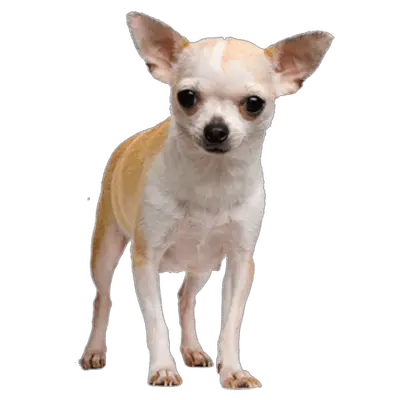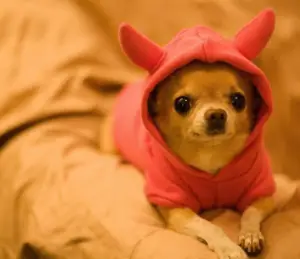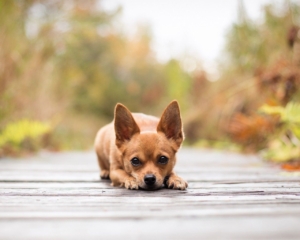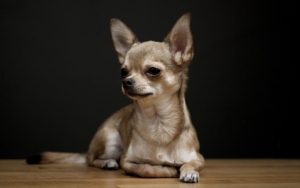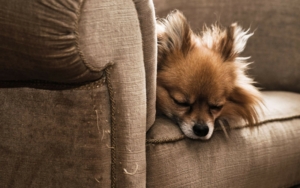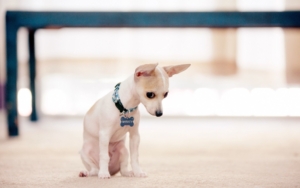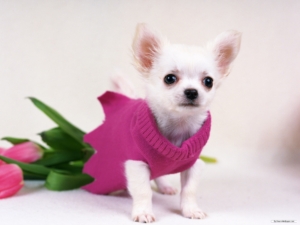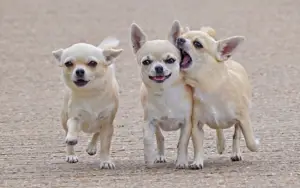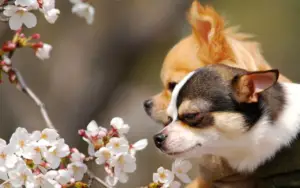In order to describe the appearance of the Chihuahua dog breed we must first look at the Breed standards. These are a set of guidelines which are used to ensure that the animals produced by a breeder or breeding facility conform to the specifics of the standardised breed. The Breed standards are written to reflect the use or purpose of the species and breed of the animal. It helps define the ideal animal of a breed and provides goals for breeders in order to improve stock. In essence a breed standard is a blueprint for an animal fit in line with the function for which it was bred – i.e. herding, tracking etc…
The Chihuahua dog breed standards do not specify height, but do specify the weight proportions. A Chihuahua is usually between 15 and 23 centieters (6”-9”) but can grow up to 40cm (15”). The standards state that the Chihuahua dog breed must not weigh over 2.7kg (6lb). Note that Breeding standards can differ per country. For example, the French Dog federation claims the dog can weigh up to 3kg (6.6lb). If your desire is to enter canine competitions with your Chihuahua it is often advised to aim for the lower weight. But do keep your Chihuahua healthy!
Pet Chihuahuas often go above these advised weights. 10 pounds or even higher is still an acceptable weight for your dog. Oversized Chihuahuas are often seen in some of the best and worst bloodlines, it is not an immediate sign of weakness. Moreover, larger breeding females are less likely to experience dystocia. That being said, please do consult your vet and personal judgement in order to judge whether or not your dog is overweight. Your vet will be able to advise you on your pet’s ideal weight taking its dimensions into account.
At birth Chihuahuas have large, round eyes and large, erect ears, set in a high, dramatically rounded skull. The coat is usually developed overtime.
The Chihuahua Coat
The coat of the Chihuahua dog breed comes in all colours and combinations. Unlike most other dog breeds, there is no dominant coat colour. Colours and patterns are not genetically marked. There are several types of Chihuahuas, but each Chihuahua has its unique coat.
The colours and patterns can influence one another, resulting in the variety of Chihuahua coats you see today. Most common colours – solid or patterned coats – are:
- Tri-colored is any combination of three colors although the major color is often brown or black. The white is mostly situated on the underside of the body, such as on the chest and the feet.
- Merle is a variation on the tri-color with the difference that the pattern is not uniform. The colors are divided in a pattern of marbled spots in the coat. Merle Chi’s often have a unique eye color such as blue.
- Piebald also known as Pied, indicates that the Chi is completely white with exception of its head, tail base and small parts of its back.
- Brindle also known as ‘tiger striped’ is a pattern of stripes that tend to be darker than the base of the coat.
- Sable pattern is more common in long-haired coat Chihuahuas butit can also exist for short-haired ones. Chihuahuas with a sable pattern have a darker top coat compared to their bottom.
In competition, no colour is favored over the other.
There is however an uncommon pattern , the merle coat pattern, which will either be disqualified from or be refused registration to competitions. This pattern is not considered part of the Chihuahua dog breed. Furthermore, as this is the result of mixing, the Kennel club will not accept the registration of these breeds. The health risks associated with the gene responsible for this coat is disadvised by the breed standard.
On that note, teacup – fawn – merle and sometimes cases deer head Chihuahuas are not allowed in competition.
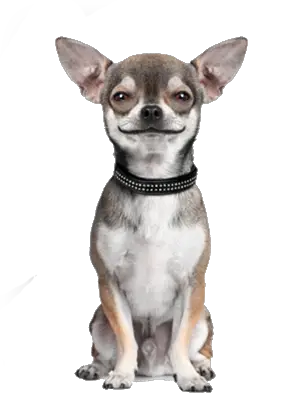
Size
The Chihuahua dog breed standards do not specify height, but do specify the weight proportions. A Chihuahua is usually between 15 and 23 centieters (6”-9”) but can grow up to 40cm (15”). The standards state that the Chihuahua dog breed must not weigh over 2.7kg (6lb).
Pet Chihuahuas can be a bit oversize and grow up to 5kg or 12lbs. Whilst this is not necessarily bad, do watch out for your dogs health. Make sure they have enough exercise and keep your dog fit! The Chihuahua can have some health issues, exercise can fight these difficulties.
Chihuahuas are known to be proud dogs. They will most likely stand with their had lifted high, cautious and proud. When feeling aggressed a Chiahuahua will bark. This is typical behavior as a consequence of fear and anger. Let the Chihuahua come to you when introducing yourself. Notice the posture and attitude to asses the situation.
Chihuahuas are quick to show their teeth. When they put their weight on their rear legs, angeling their front legs, the dog feels aggressed. Lower yourself to its level to decrease the danger you pose to the dog.
Shedding
Chihuahuas shed like all other dogs. However, as they are such small dogs, and thus have less skinsurface then other dogbreeds, they shed significantly less. The amount of shedding mainly depends on the type of coat a Chihuahua has. This has been propperly divided in 4 types of coats.
Short coat, double. This is a short outer coat, plus a woolly undercoat for insulation. Because of the two layers, this coat sheds more than single.
Short coat, single. With no undercoat, this coat looks and feels sleek and sheds less than a double coat.
Long coat, double. Long outer coat, plus wooly undercoat. This coat needs the most brushing and combing, takes more blow-drying after a bath, and sheds a good deal. Some of these dogs are so bushy they resemble Pomeranians.
Long coat, single. This “long” coat is typically shortish on the body, with feathering restricted to the ears, backs of the legs, stomach, hindquarters, and tail. A single longcoat is much easier to groom than a double longcoat, and sheds less than a double coat of either length.
